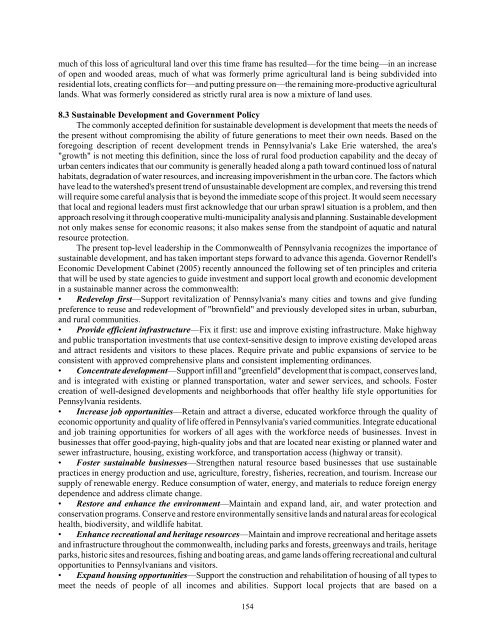Watershed Conservation Plan - Destination Erie
Watershed Conservation Plan - Destination Erie
Watershed Conservation Plan - Destination Erie
You also want an ePaper? Increase the reach of your titles
YUMPU automatically turns print PDFs into web optimized ePapers that Google loves.
much of this loss of agricultural land over this time frame has resulted—for the time being—in an increase<br />
of open and wooded areas, much of what was formerly prime agricultural land is being subdivided into<br />
residential lots, creating conflicts for—and putting pressure on—the remaining more-productive agricultural<br />
lands. What was formerly considered as strictly rural area is now a mixture of land uses.<br />
8.3 Sustainable Development and Government Policy<br />
The commonly accepted definition for sustainable development is development that meets the needs of<br />
the present without compromising the ability of future generations to meet their own needs. Based on the<br />
foregoing description of recent development trends in Pennsylvania's Lake <strong>Erie</strong> watershed, the area's<br />
"growth" is not meeting this definition, since the loss of rural food production capability and the decay of<br />
urban centers indicates that our community is generally headed along a path toward continued loss of natural<br />
habitats, degradation of water resources, and increasing impoverishment in the urban core. The factors which<br />
have lead to the watershed's present trend of unsustainable development are complex, and reversing this trend<br />
will require some careful analysis that is beyond the immediate scope of this project. It would seem necessary<br />
that local and regional leaders must first acknowledge that our urban sprawl situation is a problem, and then<br />
approach resolving it through cooperative multi-municipality analysis and planning. Sustainable development<br />
not only makes sense for economic reasons; it also makes sense from the standpoint of aquatic and natural<br />
resource protection.<br />
The present top-level leadership in the Commonwealth of Pennsylvania recognizes the importance of<br />
sustainable development, and has taken important steps forward to advance this agenda. Governor Rendell's<br />
Economic Development Cabinet (2005) recently announced the following set of ten principles and criteria<br />
that will be used by state agencies to guide investment and support local growth and economic development<br />
in a sustainable manner across the commonwealth:<br />
• Redevelop first—Support revitalization of Pennsylvania's many cities and towns and give funding<br />
preference to reuse and redevelopment of "brownfield" and previously developed sites in urban, suburban,<br />
and rural communities.<br />
• Provide efficient infrastructure—Fix it first: use and improve existing infrastructure. Make highway<br />
and public transportation investments that use context-sensitive design to improve existing developed areas<br />
and attract residents and visitors to these places. Require private and public expansions of service to be<br />
consistent with approved comprehensive plans and consistent implementing ordinances.<br />
• Concentrate development—Support infill and "greenfield" development that is compact, conserves land,<br />
and is integrated with existing or planned transportation, water and sewer services, and schools. Foster<br />
creation of well-designed developments and neighborhoods that offer healthy life style opportunities for<br />
Pennsylvania residents.<br />
• Increase job opportunities—Retain and attract a diverse, educated workforce through the quality of<br />
economic opportunity and quality of life offered in Pennsylvania's varied communities. Integrate educational<br />
and job training opportunities for workers of all ages with the workforce needs of businesses. Invest in<br />
businesses that offer good-paying, high-quality jobs and that are located near existing or planned water and<br />
sewer infrastructure, housing, existing workforce, and transportation access (highway or transit).<br />
• Foster sustainable businesses—Strengthen natural resource based businesses that use sustainable<br />
practices in energy production and use, agriculture, forestry, fisheries, recreation, and tourism. Increase our<br />
supply of renewable energy. Reduce consumption of water, energy, and materials to reduce foreign energy<br />
dependence and address climate change.<br />
• Restore and enhance the environment—Maintain and expand land, air, and water protection and<br />
conservation programs. Conserve and restore environmentally sensitive lands and natural areas for ecological<br />
health, biodiversity, and wildlife habitat.<br />
• Enhance recreational and heritage resources—Maintain and improve recreational and heritage assets<br />
and infrastructure throughout the commonwealth, including parks and forests, greenways and trails, heritage<br />
parks, historic sites and resources, fishing and boating areas, and game lands offering recreational and cultural<br />
opportunities to Pennsylvanians and visitors.<br />
• Expand housing opportunities—Support the construction and rehabilitation of housing of all types to<br />
meet the needs of people of all incomes and abilities. Support local projects that are based on a<br />
154





